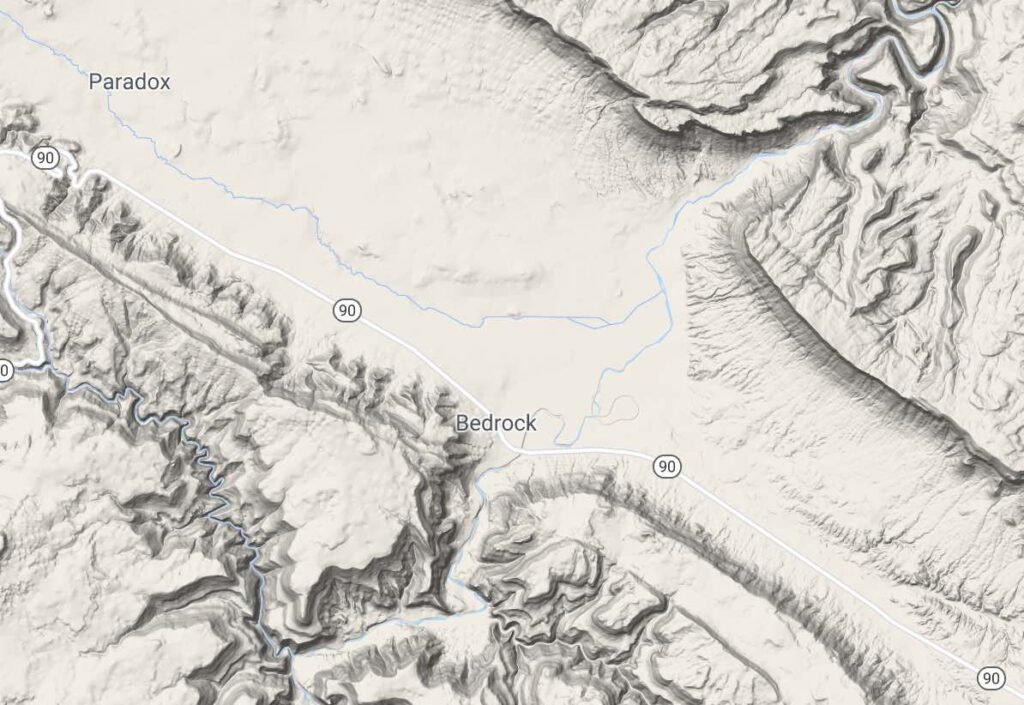It’s a paradox.
How does a search engine decide that my website is a good source of information on the naming of the tiny town of Paradox, Colorado? I’d mentioned it only one time in a most innocuous way. I’d been examining a kink in the boundary between Colorado and neighboring Utah.
Back then I said that I was “… totally enjoying the thought that the anomaly occurs near a town and valley named Paradox.” That’s the entirety of the reference. A search engine considered this meaningless observation a nugget of great value. It’s not, but I can’t disappoint the masses — assuming “masses” is defined as a single individual who found my website randomly and will likely never return after viewing a page that sat in obscurity for eighteen months.

Let’s explore this paradoxical situation in Paradox, Colorado.
Two minutes later… OK, I found out why Twelve Mile Circle scores higher that one would expect on search engine queries. There is very little information about the town of Paradox and not much more about the adjoining valley either. It’s not totally barren. I can still poke around the recesses of the Intertubes and solve the riddle.
The Town of Paradox
I’ll start with Paradox, the town. It’s on the map. Barely. Remember when we all used to get excited as Google Maps added each new nation or city to Street View? It makes one feel wistful for those long ago days of 2008. Street View has become nearly ubiquitous in North America and Western Europe to the point where it’s taken for granted. Paradox is so remote, however, that Street View hasn’t arrived there yet. It comes close but the best we can see are a few dots marking homesteads on the back edge of the distant valley floor.
Paradox is so small that even Wikipedia includes barely a mention. The best source I found was the local Paradox Valley School where only five teachers cover the full educational needs of every child, pre-school through eighth grade:
“The post office is the only place with a paved parking lot in Paradox. This is also where you will find our fire trucks and other emergency vehicles. Striking red mesas form two majestic walls that run the length of the valley. Public lands and open range make up the valley floor. While to the east and the west the San Jaun and La Sal mountain ranges sit serenely in the distance as if quietly guarding the peace of this desert town. The small town of Paradox is home to about 250 people.”
Fifteen Minutes of Fame?
Oh, and let’s not forget this interesting tidbit of particularly obscure trivia:
“Perhaps Paradox’s most famous big screen moments are found in the 1991 film Thelma and Louise.”
I’m not sure why I found that so deliciously tantalizing but I’ll have to raid my wife’s pile of vintage early 90’s VHS cassettes and see if I can find a copy of Thelma and Louise tucked somewhere down below the clutter. I desperately want to see this Paradox in glorious video. I’m not sure we have a functioning videotape machine anymore. Such a dilemma.
Paradoxical Source

I’ve dangled this paradox in front of the loyal readership of Twelve Mile Circle for long enough. The town of Paradox is named after the Paradox Valley. No surprise. The valley gets its name from its status as a geo-oddity. I’ve highlighted the northwestern half of the valley in terrain mode to enhance the obviousness once it’s mentioned.
One thinks of water carving valleys. That also came to the minds of Nineteenth Century explorers and geologists who first surveyed the territory here. However, they noticed a distinct lack of water running down the length of this 25-mile valley corralled by steep cliff walls. Instead, a river cuts across the valley. The Dolores River, a tributary of the Colorado River, seemed to defy conventional wisdom and that was the paradox.
In reality, the river came first. It carved a path through solid stone like many other rivers have done throughout the rugged southwestern United States. Later, the area of the valley sank slowly down from the heights of the surrounding plain as ancient salt deposits eroded beneath it.
Two geological events. One location. Paradox resolved.

Leave a Reply